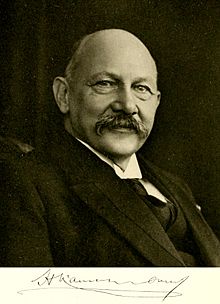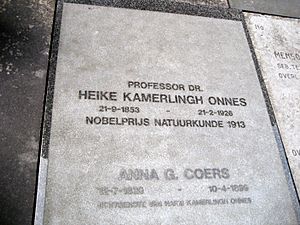Heike Kamerlingh Onnes facts for kids
Quick facts for kids
Heike Kamerlingh Onnes
|
|
|---|---|
 |
|
| Born |
Heike Kamerlingh Onnes
21 September 1853 Groningen, Netherlands
|
| Died | 21 February 1926 (aged 72) Leiden, Netherlands
|
| Nationality | Netherlands |
| Alma mater | Heidelberg University University of Groningen |
| Known for | Liquid helium Onnes-effect Superconductivity Virial equation of state Coining the term “enthalpy” Kamerlingh Onnes Award |
| Awards | Matteucci Medal (1910) Rumford Medal (1912) Nobel Prize in Physics (1913) Franklin Medal (1915) |
| Scientific career | |
| Fields | Physics |
| Institutions | University of Leiden Delft Polytechnic |
| Doctoral advisor | Rudolf Adriaan Mees |
| Other academic advisors | Robert Bunsen Gustav Kirchhoff Johannes Bosscha |
| Doctoral students | Jacob Clay Wander de Haas Gilles Holst Johannes Kuenen Pieter Zeeman |
| Influences | Johannes Diderik van der Waals |
| Influenced | Willem Hendrik Keesom Cryogenics |
Heike Kamerlingh Onnes (born September 21, 1853 – died February 21, 1926) was a famous Dutch physicist. He won the Nobel Prize for his amazing work.
Heike Kamerlingh Onnes was the first person to make liquid helium in 1908. He also found out about superconductivity in 1911. This is when some materials can carry electricity with no resistance at very cold temperatures.
Contents
About Heike Kamerlingh Onnes
Early Life and Education
Heike Kamerlingh Onnes was born in Groningen, Netherlands. His father owned a brick factory.
In 1870, he started studying at the University of Groningen. He also studied at the University of Heidelberg in Germany. He earned his master's degree in 1878 and his doctorate in 1879. From 1878 to 1882, he worked as an assistant at the Delft Polytechnic.
Family Life
Heike Kamerlingh Onnes married Maria Adriana Wilhelmina Elisabeth Bijleveld in 1887. They had one child, a son named Albert. His brother, Menso Kamerlingh Onnes, was a well-known painter.
Work at Leiden University
From 1882 to 1923, Kamerlingh Onnes was a professor of experimental physics at Leiden University. In 1904, he started a very large lab for cryogenics. This is the study of extremely cold temperatures. He invited other scientists to work there, which made his lab very famous. Today, it is called the Kamerlingh Onnes Laboratory.
Making Liquid Helium
On July 10, 1908, Heike Kamerlingh Onnes did something amazing. He was the first person to turn helium gas into a liquid. He used special cooling methods to get the temperature down to about -269 °C (4.2 K). This was the coldest temperature ever reached on Earth at that time! His equipment is now in the Museum Boerhaave in Leiden.
Discovering Superconductivity
In 1911, Kamerlingh Onnes was studying how metals conduct electricity at very low temperatures. He tested pure metals like mercury, tin, and lead. Scientists had different ideas about what would happen. Some thought electricity would stop completely at super cold temperatures. Others, including Onnes, thought the resistance would disappear.
On April 8, 1911, he made a huge discovery. He found that at 4.2 K, the electrical resistance in a mercury wire suddenly vanished. This meant the mercury could carry electricity perfectly, with no energy loss. He called this new state "superconductive." He later used the term "superconductivity."
His work earned him the 1913 Nobel Prize in Physics. The award was for his research on materials at low temperatures, especially for making liquid helium.
His Lasting Impact

You can see some of the tools he invented at the Boerhaave Museum in Leiden. The machine he used to liquefy helium is on display at Leiden University. The low-temperature lab there is also named after him. His student, Willem Hendrik Keesom, was the first to make solid helium in 1926.
The Kamerlingh Onnes Award is given to scientists who make new discoveries in low-temperature science. The "Onnes effect" is also named after him. This effect describes how superfluid helium can creep up walls.
There is even a crater on the Moon named Kamerlingh Onnes! He is also known for creating the word "enthalpy," which is a term used in physics and chemistry. In 2011, his discovery of superconductivity was recognized as an important IEEE Milestone.
Awards and Recognition
- Matteucci Medal (1910)
- Rumford Medal (1912)
- Nobel Prize in Physics (1913)
- Franklin Medal (1915)
Images for kids
See also
 In Spanish: Heike Kamerlingh Onnes para niños
In Spanish: Heike Kamerlingh Onnes para niños



